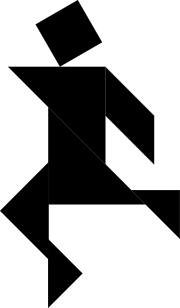| O Tangram é um puzzle que pode divertir toda a família.
Não requer uma grande habilidade ou perícia - apenas paciência,
tempo e, acima de tudo, imaginação! Há centenas de puzzles por
peças ou figuras separadas em várias peças. O Tangram é o mais
interessante de todos os puzzles por peças.
Pouco se sabe acerca do inventor
ou da origem do Tangram. Até a origem do nome é obscura.
De acordo com Samuel Loyd, o
perito americano em puzzles, o deus Tan inventou o puzzle à 4000
anos e explicou-o nos Sete Livros de Tan. Cada volume continha mais
de 1000 puzzles que supostamente ilustravam a criação do mundo e a
origem das espécies. As sete peças foram tiradas do sol, da lua e
de cinco planetas - Marte, Júpiter, Saturno, Mercúrio e Vénus. A
sua história foi mais tarde desmascarada como uma elaborada, sem
bases e erudita intrujice.
Segundo alguns, o nome Tangram é
uma corrupção da palavra inglesa obsoleta 'trangam', que significa
puzzle ou bugiganga. Outros dizem que derivou do barco cantonês
tanka, onde raparigas entretiam os marinheiros americanos. Outros
explicam que a palavra derivou da dinastia chinesa Tang. Uma
história conta que o Tangram foi inventado por um homem chamado Tan
acidentalmente quando ele tentava reunir as peças de um azulejo
partido. Na Ásia é chamado de 'Sete placas da Sabedoria'. Na China
dão-lhe o nome de "Ch'i ch'iao t'u" ou de 'sete peças da
astucia'.
A referência mais antiga conhecida
é uma gravura em madeira datada de 1780 de Utamaro. O livro mais
antigo foi publicado na China em 1813. Parece certo que já é antigo
em 1813. Um dos primeiros puzzles semelhantes ao Tangram aparece
num livro publicado no Japão em 1742. Os eruditos assumem que o
Tangram começou no Oriente antes do séc. XVIII e então espalhou-se
para o ocidente . Por volta de 1818, publicações sobre o Tangram
apareceram nos Estados Unidos, Alemanha, Itália, França e
Inglaterra.
Alcançou a Europa e a América no
princípio do séc. XIX e a popularidade continua até hoje. Na China
do séc. XIX era tão popular que as formas das peças encontram-se no
desenho de pratos caixas de verniz e até mesas.
Por volta dos finais do séc. XIX,
um industrial alemão começou a produzir versões de pedra do Tangram
e de outro puzzle por peças sob o nome de "O Puzzle Âncora". O
Puzzle Âncora teve tanto sucesso que se seguiram mais de 30 novos
desenhos de conjuntos de peças. Durante a 1ª Guerra Mundial, a sua
popularidade atingiu o mais alto nível entre as tropas nas
trincheiras de ambos os lados. Thomas Edison e o presidente dos
Estados Unidos Grover Cleveland endossaram publicamente os puzzles
nos folhetos dos puzzles.
O Tangram é mesmo um jogo
intemporal amado e jogado por séculos.
|
 |
Tangram is a puzzle game that can be enjoyed by the entire
family members. It does not require an inordinate amount of
skill-just patience, time and, above all, imagination! There are
hundreds of dissection puzzles-plane or solid figures cut into
various pieces. Tangram is the most outstanding of all the
dissection puzzles.
Little is known for certain about
the inventor or the origin of the Tangram. Even the origin of the
name is obscure.
According to Samuel Loyd, the
American puzzle expert, the God Tan invented the puzzle 4,000 years
ago and described it in the Seven Books of Tan. Each volume
contained over 1,000 puzzles which were supposed to illustrate the
creation of the world and the origin of species. The seven pieces
were taken from the sun, the moon and the five planets of Mars,
Jupiter, Saturn, Mercury and Venus. His story later uncovered as a
baseless elaborate and scholarly spoof.
According to some, the name
Tangram is a corruption of the obsolete English word trangam, which
meant a puzzle or trinket. Other says it was derived from the
Cantonese riverboat tanka girls who entertained American sailors.
Other explains that the word was derived from the Tang Dynasty of
China. One story tells that Tangram was invented by a man named Tan
accidently while he tried to put broken pieces of a porcelain tile.
In Asia, it is called 'Seven Plates of Wisdom'.
The earliest known reference is a
wood cut from 1780 by Utamaro. The earliest known book was
published in 1813 in China. It seems certain that it is already old
in 1813. One of Tangram-like puzzles first appeared in a book
published in Japan in 1742. Scholars assume that Tangram began in
Orient before 18th century and then spread westward. By 1818,
Tangram publications had appeared in the Unite States, Germany,
Italy, France and England. It swept through Europe and America at
the beginning of 19th century and its popularity continues to this
day. In 19th century China, it was so popular that the shape of the
pieces found their way into the design of dishes, lacquer boxes and
even tables.
Toward the end of 19th century, a
German industrialist began to produce stone versions of Tangram and
other dissection puzzles under the name of 'The Anchor Puzzle'. The
Anchor puzzles were so successful that over 30 new designs of
puzzle sets were followed. During the World War I, its popularity
reached to the highest level among the troops in the trenches of
both sides. Thomas Edison and U. S. President Grover Cleveland
publicly endorsed the puzzles in the puzzle booklets.
Tangram is really a timeless game
loved and played for centuries.
|